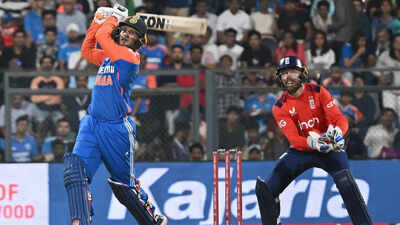ARTICLE AD BOX

NEW DELHI: Abhishek Sharma's father Rajkumar Sharma used to get really annoyed while coaching him at the Gandhi Stadium in Amritsar. Sharma says he once got so miffed that he didn’t allow him to bat for a couple of days as punishment.
In Delhi, Sanjay Bharadwaj, who has coached the likes of Gautam Gambhir, Amit Mishra, Joginder Sharma, and Unmukt Chand, scolded his NextGen ward Priyansh Arya for always looking to hit glory shots.The two southpaws are still hitting sixes for fun, but their intent forced their respective coaches to change their approach. "Priyansh added that new armoury in my coaching craft. His style of batting forced me to adapt," Bharadwaj told TimesofIndia.com after Priyansh scored a stunning 39-ball century against Chennai Super Kings (CSK) in IPL 2025.
Asia Cup 2025: India Squad Announced | Surya Named Captain, Gill Vice-Captain
Hitting a six was once a rarity in cricket; coaches often reprimanded players because playing in the ‘V’ was considered the correct way of batting. Today, if you want to find a place in T20 sides as a batter, the ability to clear the boundary at will is non-negotiable.The T20 format has also evolved since its inception almost two decades ago. Earlier, most teams followed the ODI template in T20Is -- exploit the powerplay, save wickets in the middle, and then go all guns blazing in the last five or six overs.
But over time, the notion that T20s are just a shorter version of ODIs has been firmly discarded. The format has built its own identity, where hitting sixes and scoring at a higher strike rate form the very foundation of batting.
Go Beyond The Boundary with our YouTube channel. SUBSCRIBE NOW!
With more and more data available, teams realised that scoring quickly is more valuable than preserving wickets at the cost of a slower scoring rate. As a result, line-ups were stacked with power-hitters in the middle order, and players capable of clearing the ropes at will were valued more than accumulators.The six-hitting revolutionConsider this: In 2025, Australia struck 92 sixes in just 8 T20Is, averaging one every 9.5 balls - the second-best six-hitting rate in a calendar year, behind only West Indies’ 157 sixes in 13 matches at 9.2 balls per six in 2023.In 2012, T20 matches saw a six once every 27 deliveries. Since then, the frequency has risen every year, with sixes becoming increasingly common. West Indies were the first big T20 team to crack this code: sixes are the real currency in T20s, the most efficient way to maximise value from each of the 120 deliveries.
Poll
Who do you think is the best power-hitter in T20 cricket today?
Abhishek SharmaSuryakumar YadavOther notable players
In 2016, the T20 World Cup champion West Indies men’s team struck sixes every 16.3 balls against the top seven teams, compared to once every 22.5 balls by other sides in the top eight against each other.In the eight matches they played during the 2015-16 season, the Caribbeans hit 68 sixes in 938 balls faced -- a six every 13.79 deliveries. Where do India’s batters stand?Year / TournamentMatches/InningsBalls FacedSixes HitBalls per Six India T20Is 2015 4 464 11 42.18 India T20Is 2020 10 1,162 64 18.15 India T20Is 2024 26 2877 236 12.19 IPL 2021 60 13,952 687 20.30 IPL 2025 73 16,514 1,294 12.76



.png)
.png)
.png)
















 1 hour ago
2
1 hour ago
2









 English (US) ·
English (US) ·